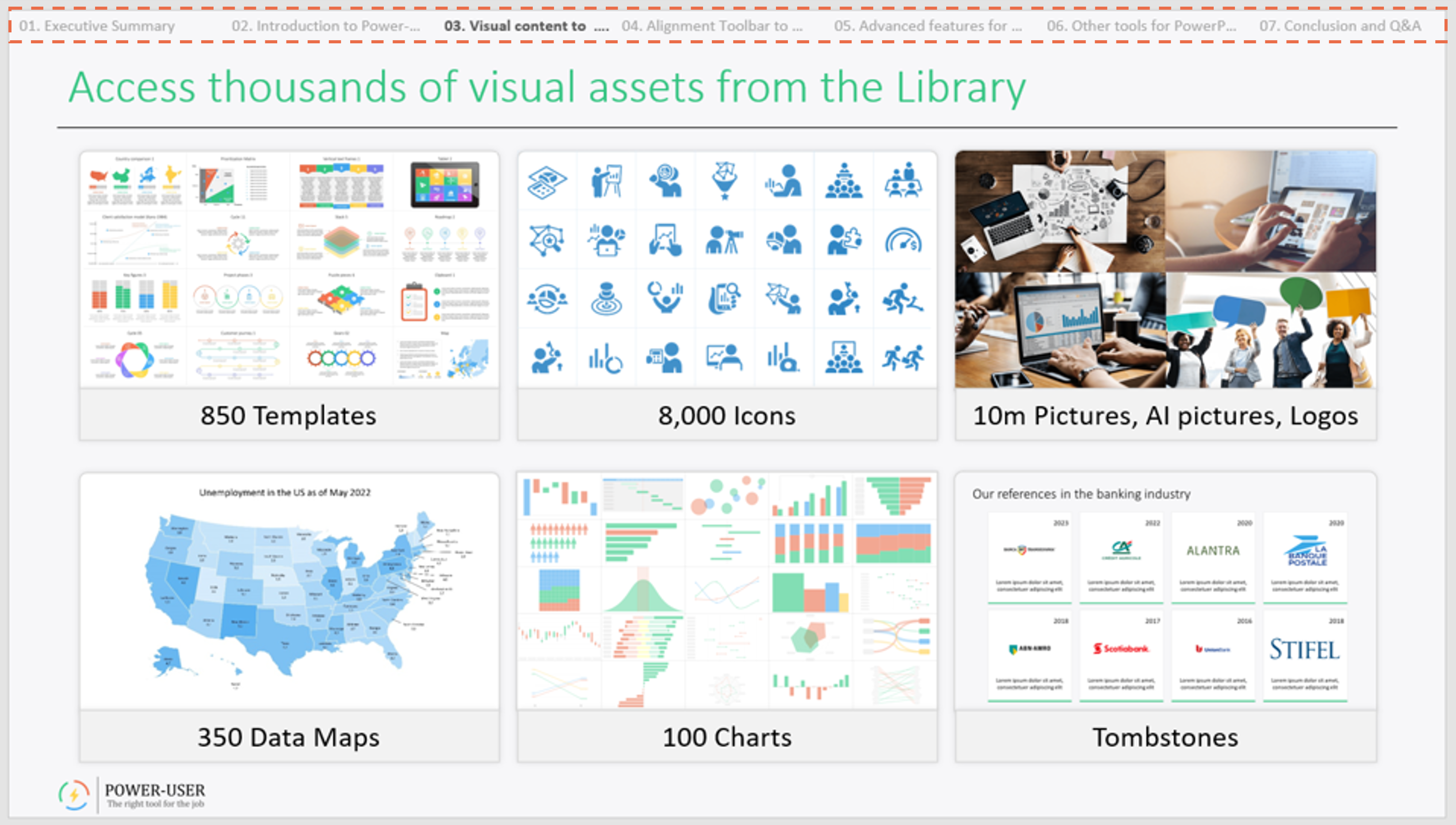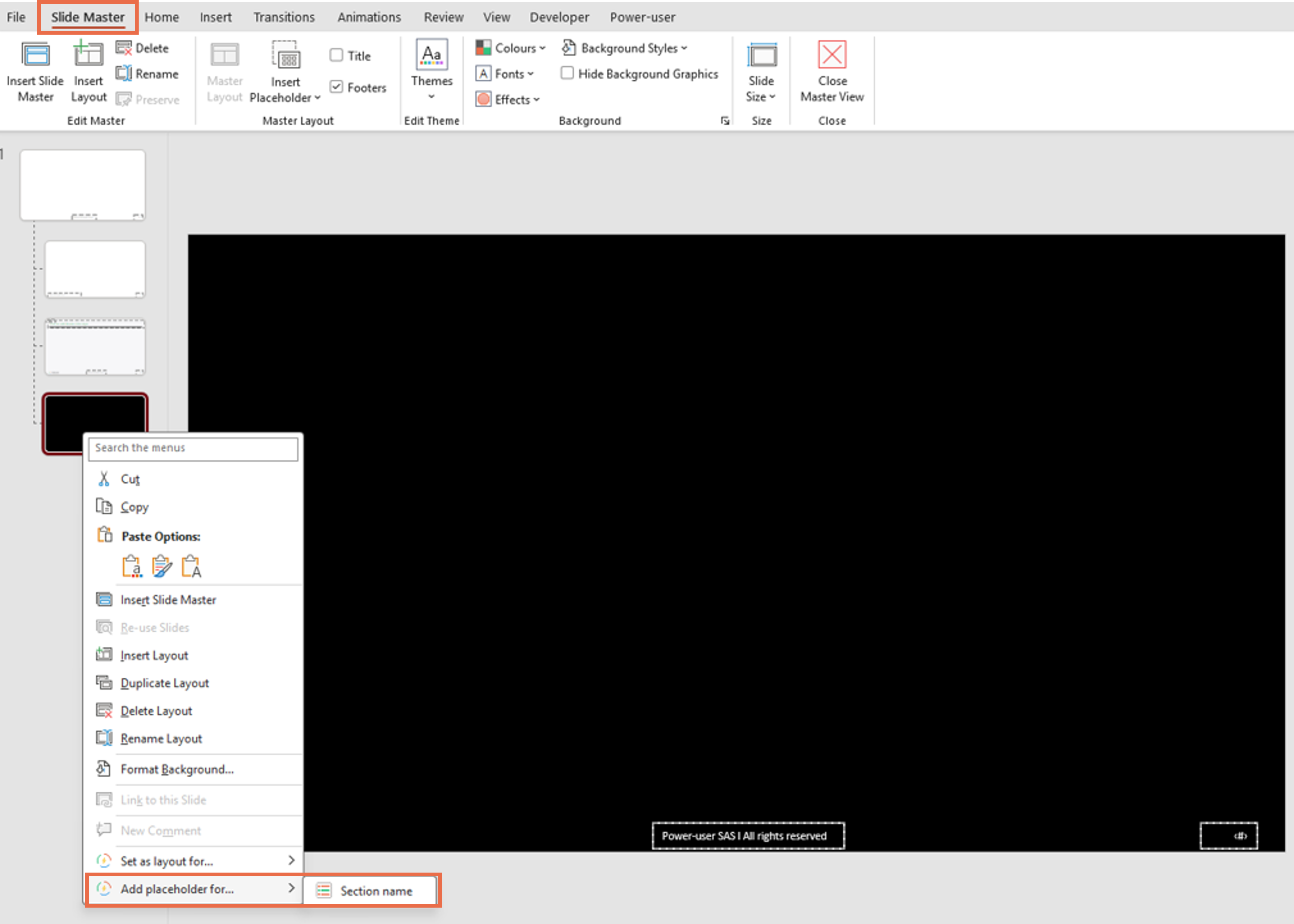The Agenda builder (CTRL+SHIFT+A) is one of the most powerful features in Power-user. This tool helps you work your storytelling and automatically structure your presentation with table of content pages that can be easily updated.
TABLE OF CONTENTS
Benefits of using the Agenda
The importance of having an agenda to structure a presentation
Any good business presentation needs to be properly structured with an Agenda. Because a presentation is a demonstration, people need to follow the logic to be convinced. A presentation's structure can be built using the Minto Pyramid Principle, a very famous methodology developped for McKinsey strategy consultants.
A table of content usually lists all indexed sections in the presentation with the corresponding page number. Very often, these pages are repeated at the beginning of each section in the presentation, with a highlight on the next section. This helps people understand which section have been seen already, what comes next, and how it is part of the bigger demonstration.
Creating agenda pages manually is a highly time-consuming process
In Microsoft Word, users can generate table of contents automatically. But unfortunately, Microsoft PowerPoint doesn't come with an equivalent feature.
So in PowerPoint, users have to create agenda pages manually, listing section numbers, section names, page numbers, etc. If the agenda is duplicated for each section, it becomes very long to update them. For every new section or slide added or deleted, all the objects need to be adjusted and aligned again, on each agenda page. So if you have 10 sections already, it means you will have to replicate all your changes 10x, something that can a huge amount of time.
About the Power-user Agenda
With Power-user, you can create, design and update agenda pages automatically in your entire presentation:
- Simply list your sections once (or load sections already existing in your presentatino),
- Easily edit section names and slide titles to build a compelling storyline for your audience,
- Select your preferred visual style, switch between using a table of content or a divider format, and easily customize the agenda pages with your colors, numbering style, etc,
- Whenever there are changes to your structure, update all the agenda pages at once with just 1 click!
This feature can save you 20 min every time you have to update the agenda for your presentation, while ensuring it's always up to date and error-free.

How to create an Agenda with Power-user
Opening the Agenda
From the Power-user tab, click the Agenda button located at the center of the ribbon, under the Format menu.
Once you have clicked Agenda, Power-user will open the below task pane at the right of your screen, like shown below:
Creating the Agenda structure
From the Agenda task pane shown above, you can create the presentation for your agenda. The pane lists all your sections and slide titles, and lets you structure them:
- Click "New section" for each section to add.
- Click a section name in the list to rename it.
- Increase or decrease indent to to have sections and sub-sections.
- Move your slides and sections up or down with the up/down arrows.

We recommend using this pane for working on your storytelling first. You can make sure that your section names are consistent with your slide titles, and that the all presentation will unfold in a natural and compelling way to convince your audience.
Once you are happy with your presentation structure, click Update at the bottom of the pane. Power-user will create any missing agenda page in the presentation, and update all existing pages.
Customizing the Agenda design
Customizing Table of Content slides
Once you have created a default table of content, you will want to customize it to match your own brand and style.
Each type of item can be edited separately, so that you have complete flexibility in terms of what to do for section numbers, section names and slide numbers, for both inactive sections and for the highlighted section.
To edit an item of the agenda page, just click it and edit with the usual PowerPoint interface. You can change colors, font sizes, add bold/italic/underline, change the text margins or the shape types and a lot more so that this item looks exactly how you need it.
Once an item it ready, just click "Apply to all" from the contextual menu on that shape to reflect these changes on all similar objects for all your agenda pages.

Below are a few examples of custom Table of Content pages which users can create and udpate automatically with the Power-user Agenda.

Customizing Dividers
If you are opting for Dividers instead of repeating the entire table of content on each agenda page, you can also customize how these Dividers should look.
Similarly as for Table of Content pages, you can edit the appearance of the items on the slide (the section number, the section name or decorative shapes). You can also directly position these shapes where you want them on the slide.
Then click "Apply to all" so that your changes are reflected on every Divider slide.
Below are some examples of Dividers you can generate automatically.

Other design options
Click the Design tab of the Agenda pane to access the options for customizing the Agenda design:

From here you can:
- Switch between using a Table of content format at the beginning of each section, or just Dividers.
- Add or remove a Cover page at the beginning of the presentation, which is an additional table of content slide, without highlight on any specific section.
- Add or remove slide numbers on your agenda pages.
- Add or remove section numbers on your agenda pages.
- Customize the style of the section numbers, for instance 1) 2) 3), or I, II, III, or A, B, C. You can edit the style for each level of section.
- Customize the title of Table of content pages.
- Define if subsections should be listed on all agenda pages, or just on the pages of the corresponding section.
- Change the position of the agenda on the slide. You can customize the top/left/right/bottom margins to place the agenda exactly where you need it to be.
Once you have made your changes, click Update to apply them in the presentation.
Customizing the layout for Agenda pages
All slides are based on the layout from the Slide Master, so when an Agenda page is created, Power-user will initially use a layout by default.
You may want to actually change which layout to use for Table of Content pages or Dividers. Using the right layout willa llow you to immediately have the size and position for your titles, logos and other items.
To customize the layout, prepare the layout of your choice in the Master View. Then right-click a slide, and choose Set as Agenda layout or Set as Divider layout.

This will tell Power-user to always use this layout for when you create or update agenda pages.
We recommend admins to choose a corporate layout, and click Set as Agenda layout in their corporate master before releasing the master to all their users.
Breadcrumbs
The Power-user Agenda can be linked to Breadcrumbs that will show on each slide the current section, and how it fits in the presentation's agenda, like illustrated below.
Breadcrumbs can be activated from the Agenda's Design tab. They can include:
- Only the current section name,
- Or all section names in the presentation, with a distinctive format highlighting the current section.
To define the position and format of Breadcrumbs, you can move and edit directly the Breadcrumbs on the slide, then click "Apply to all" to replicate the format and respective position to all other sections.
Breadcrumbs can also be made visible or have a different format for slides with specific layouts. For instance, you may want the text to be black on slides with a white background, but to turn white on slides with a dark background. To manage this, go to your presentation's Slide Master View, then right-click a layout and hit "Add placeholder for" > "Section name". Position and format the placeholder, then copy and paste it on other placeholders, adjusting the position and format for each placeholder. When you update the Power-user Agenda, the format and position will adjust to the placeholders set for each layout.

The Power-user Agenda - but also Breadcrumbs - all contain hyperlinks to each section, so you can click it to go to the relevant part of the presentation. It remains clickable if you use "Save as" > "PDF", however the links will be removed if you use "Print" > "PDF" instead.
Was this article helpful?
That’s Great!
Thank you for your feedback
Sorry! We couldn't be helpful
Thank you for your feedback
Feedback sent
We appreciate your effort and will try to fix the article
